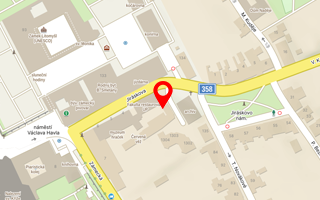Preventive conservation, securing and preservation of the cycle of murals in the Emmaus Monastery in Prague
Provider: Deutsche Bundesstiftung Umwelt
Programme: Dotační téma
Implementation period: 01.01.23 - 31.12.25
Workplace:
Fakulta restaurování - Ateliér restaur. nástěn.malby a sgrafita
Investigator: Vojtěchovský JanTeam member: Bayer Karol
Description:
The medieval wall paintings in the cloister of the Emmaus Monastery in Prague are a nationally and internationally important cultural asset. The Emmaus cycle, which includes 26 figurative paintings in 22 vaulted bays, is a rare relic of central and northern European Gothic wall painting of enormous proportions. The paintings date from the second half of the 14th century, when Prague was the cultural center of the Holy Roman Empire under Emperor Charles IV. Despite its poor condition, of which three paintings survive only in fragments, the scheme has complex iconography and is of the highest artistic quality. The murals have been repainted several times, with the first repainting occurring around 50 years after they were created, possibly due to weather damage as the cloister was open to the Garden of Paradise at the time. The cloister was then glazed in the 17th century and is now enclosed by the present post-WWII glazing, which faces the courtyard. However, the condition of the murals today indicates the long-term negative effects of environmental influences and atmospheric pollution. The question arises as to how fluctuations in relative humidity and condensation processes affect the paintings. In addition, it is unclear, for example, what role soluble salts and microbiology play in the past and current processes of deterioration of the paintings. Considering that the complex investigation as well as the conservation, restoration and preservation of such extensive cycles of medieval wall paintings is exceptional even on an international scale, the project can be combined with the interpretation of acquired insights and knowledge for the long-term conceptual maintenance of similar Wall painting cycles can be exemplary. The focus is then on the use of the results and the cooperation of the team of experts composed of different departments for the development of conservation and restoration concepts and the resulting conservation measures, taking into account technical, technological, artistic, monument preservation and ethical aspects. The knowledge gained will make an important contribution to the techniques and materials used in medieval wall paintings in the European cultural area. One can also expect new, more accurate information about the damage and causes of damage to murals of this type that have been exposed to a large city or an industrial environment for a long time. The results will be published on an international level and thus an impact as well as a resonance from the professional community in Europe and possibly all over the world can be expected. The demonstration of cross-border cooperation between German and Czech institutions can also be a good example and motivation for similar research activities in this narrowly specialized and relatively conservative sector.
The medieval wall paintings in the cloister of the Emmaus Monastery in Prague are a nationally and internationally important cultural asset. The Emmaus cycle, which includes 26 figurative paintings in 22 vaulted bays, is a rare relic of central and northern European Gothic wall painting of enormous proportions. The paintings date from the second half of the 14th century, when Prague was the cultural center of the Holy Roman Empire under Emperor Charles IV. Despite its poor condition, of which three paintings survive only in fragments, the scheme has complex iconography and is of the highest artistic quality. The murals have been repainted several times, with the first repainting occurring around 50 years after they were created, possibly due to weather damage as the cloister was open to the Garden of Paradise at the time. The cloister was then glazed in the 17th century and is now enclosed by the present post-WWII glazing, which faces the courtyard. However, the condition of the murals today indicates the long-term negative effects of environmental influences and atmospheric pollution. The question arises as to how fluctuations in relative humidity and condensation processes affect the paintings. In addition, it is unclear, for example, what role soluble salts and microbiology play in the past and current processes of deterioration of the paintings. Considering that the complex investigation as well as the conservation, restoration and preservation of such extensive cycles of medieval wall paintings is exceptional even on an international scale, the project can be combined with the interpretation of acquired insights and knowledge for the long-term conceptual maintenance of similar Wall painting cycles can be exemplary. The focus is then on the use of the results and the cooperation of the team of experts composed of different departments for the development of conservation and restoration concepts and the resulting conservation measures, taking into account technical, technological, artistic, monument preservation and ethical aspects. The knowledge gained will make an important contribution to the techniques and materials used in medieval wall paintings in the European cultural area. One can also expect new, more accurate information about the damage and causes of damage to murals of this type that have been exposed to a large city or an industrial environment for a long time. The results will be published on an international level and thus an impact as well as a resonance from the professional community in Europe and possibly all over the world can be expected. The demonstration of cross-border cooperation between German and Czech institutions can also be a good example and motivation for similar research activities in this narrowly specialized and relatively conservative sector.
